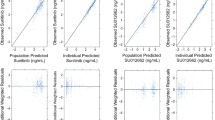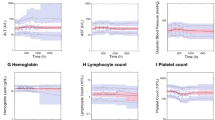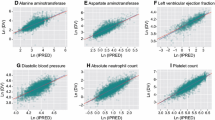Abstract
Purpose
In this pharmacokinetic/pharmacodynamic meta-analysis, we investigated relationships between clinical endpoints and sunitinib exposure in patients with advanced solid tumors, including patients with gastrointestinal stromal tumor (GIST) and metastatic renal cell carcinoma (mRCC).
Methods
Pharmacodynamic data were available for 639 patients of whom 443 had pharmacokinetic data. Sunitinib doses ranged from 25 to 150 mg QD or QOD. Models to express endpoint values and/or changes from baseline by the highest-correlating exposure measures were developed in S-PLUS or NONMEM using fixed- and mixed-effects modeling.
Results
Tentative relationships were identified between (1) steady-state AUC of total drug (sunitinib + its active metabolite SU12662) and time to tumor progression (TTP), overall survival (OS), with AUC significantly associated with longer TTP and OS in patients with GIST and mRCC, and incidence, but not severity, of fatigue; (2) steady-state AUC of sunitinib and response probability, with AUC significantly associated with objective response in patients with mRCC and stable disease in patients with both mRCC and GIST (with no such correlations in patients with solid tumors); (3) dose and tumor size reductions; (4) total drug concentration and diastolic blood pressure (DBP), with a typical patient on sunitinib 50 mg QD (the recommended dose) predicted to experience a maximum DBP increase of 8 mmHg; and (5) cumulative AUC of total drug and absolute neutrophil count (ANC), with ANC reductions occurring predominantly after one treatment cycle.
Conclusions
The results of this meta-analysis indicate that increased exposure to sunitinib is associated with improved clinical outcomes (longer TTP, longer OS, greater chance of antitumor response), as well as some increased risk of adverse effects. A sunitinib 50-mg starting dose seems reasonable, providing clinical benefit with acceptably low risk of adverse events.












Similar content being viewed by others
References
Abrams TJ, Lee LB, Murray LJ et al (2003) SU11248 inhibits KIT and platelet-derived growth factor receptor beta in preclinical models of human small cell lung cancer. Mol Cancer Ther 2:471–478
Faivre S, Delbaldo C, Vera K et al (2006) Safety, pharmacokinetic, and antitumor activity of SU11248, a novel oral multitarget tyrosine kinase inhibitor, in patients with cancer. J Clin Oncol 24:25–35
O’Farrell AM, Foran JM, Fiedler W et al (2003) An innovative phase I clinical study demonstrates inhibition of FLT3 phosphorylation by SU11248 in acute myeloid leukemia patients. Clin Cancer Res 9:5465–5476
Kim DW, Jo YS, Jung HS et al (2006) An orally administered multi-target tyrosine kinase inhibitor, SU11248, is a novel potent inhibitor of thyroid oncogenic RET/papillary thyroid cancer kinases. J Clin Endocrinol Metab 91:4070–4076
Mendel DB, Laird AD, Xin X et al (2003) In vivo antitumor activity of SU11248, a novel tyrosine kinase inhibitor targeting vascular endothelial growth factor and platelet-derived growth factor receptors: determination of a pharmacokinetic/pharmacodynamic relationship. Clin Cancer Res 9:327–337
Murray LJ, Abrams TJ, Long KR et al (2003) SU11248 inhibits tumor growth and CSF-1R-dependent osteolysis in an experimental breast cancer bone metastasis model. Clin Exp Metastasis 20:757–766
O’Farrell AM, Abrams TJ, Yuen HA et al (2003) SU11248 is a novel FLT3 tyrosine kinase inhibitor with potent activity in vitro and in vivo. Blood 101:3597–3605
Burstein HJ, Elias AD, Rugo HS et al (2008) Phase II study of sunitinib malate, an oral multitargeted tyrosine kinase inhibitor, in patients with metastatic breast cancer previously treated with an anthracycline and a taxane. J Clin Oncol 26:1810–1816
Socinski MA, Novello S, Brahmer JR et al (2008) Multicenter, phase II trial of sunitinib in previously treated, advanced non-small-cell lung cancer. J Clin Oncol 26:650–656
Bello CL, Sherman L, Zhou J et al (2006) Effect of food on the pharmacokinetics of sunitinib malate (SU11248), a multi-targeted receptor tyrosine kinase inhibitor: results from a phase I study in healthy subjects. Anticancer Drugs 17:353–358
Sakamoto KM (2004) SU-11248 Sugen. Curr Opin Invest Drugs 5:1329–1339
Bello CL, Bu H-Z, Patyna S et al (2007) A phase I mass-balance study to evaluate the metabolism and excretion of [14C]-sunitinib in healthy male subjects. Poster presented at the annual meeting of the American Association for Cancer Research, Los Angeles, 2007 (Abstract 9072)
SUTENT® prescribing information (revised November 2008) Pfizer Labs, Division of Pfizer Inc., New York. Available at: http://www.sutent.com. Accessed Feb 2009
Demetri DG, George S, Heinrich MC et al (2003) Clinical activity and tolerability of the multi-targeted tyrosine kinase inhibitor SU11248 in patients with malignant gastrointestinal stromal tumors refractory to imatinib mesylate. Presented at the 39th annual meeting of the American Society of Clinical Oncology, Chicago, 31 May–3 June 2003 (Abstract 3273). Available at: http://www.asco.org. Accessed Mar 2009
Rosen L, Mulay M, Long J et al (2003) Phase I trial of SU011248, a novel tyrosine kinase inhibitor in advanced solid tumors. Presented at the 39th annual meeting of the American Society of Clinical Oncology, Chicago, 31 May–3 June 2003 (Abstract 765). Available at: http://www.asco.org. Accessed Mar 2009
Houk BE, Bello CL, Kang D, Amantea M (2009) A population pharmacokinetic meta-analysis of sunitinib malate (SU11248) and its primary metabolite (SU12662) in healthy volunteers and oncology patients. Clin Cancer Res 15:2497–2506
Maki RG, Fletcher JA, Heinrich MC et al (2005) Results from a continuation trial of SU11248 in patients (pts) with imatinib (IM)-resistant gastrointestinal stromal tumor (GIST). Presented at the 41st annual meeting of the American Society of Clinical Oncology, Orlando, 13–17 May 2005 (Abstract 9011). Available at: http://www.asco.org. Accessed Mar 2009
Demetri GD, van Oosterom AT, Garrett CR et al (2006) Efficacy and safety of sunitinib in patients with advanced gastrointestinal stromal tumour after failure of imatinib: a randomised controlled trial. Lancet 368:1329–1338
Motzer RJ, Michaelson MD, Redman BG et al (2006) Activity of SU11248, a multi-targeted inhibitor of vascular endothelial growth factor receptor and platelet-derived growth factor receptor, in patients with metastatic renal cell carcinoma. J Clin Oncol 24:16–24
Motzer RJ, Rini BI, Bukowski RM et al (2006) Sunitinib in patients with metastatic renal cell carcinoma. JAMA 295:2516–2524
Therasse P, Arbuck SG, Eisenhauer EA et al (2000) New guidelines to evaluate the response to treatment in solid tumors. European Organization for Research and Treatment of Cancer, National Cancer Institute of the United States, National Cancer Institute of Canada. J Natl Cancer Inst 92:205–216
Beal SL, Sheiner LB (1998) NONMEM users guides—Part I–VIII. NONMEM Project Group C255, University of California at San Francisco, San Francisco, 1988–1998
Fleming TR, Harrington DP (1991) Counting processes and survival analysis. Wiley Interscience, New York
Gieschke R, Burger HU, Reigner B et al (2003) Population pharmacokinetics and concentration–effect relationships of capecitabine metabolites in colorectal cancer patients. Br J Clin Pharmacol 55:252–263
Sheiner LB (1994) A new approach to the analysis of analgesic drug trials, illustrated with bromfenac data. Clin Pharmacol Ther 56:309–322
Claret L, Girard P, Zuideveld KP et al (2006) A longitudinal model for tumor growth size measurement in clinical oncology studies. Presented at the 15th annual meeting of the Population Approach Group in Europe, Bruges, Belgium, 14–16 June 2006 (Abstract 1004). Available at: http://www.page-meeting.org/page/page2006/P2006II_10.pdf. Accessed Mar 2009
Mould DR, Holford NH, Schellens JH et al (2002) Population pharmacokinetic and adverse event analysis of topotecan in patients with solid tumors. Clin Pharmacol Ther 71:334–348
Kowalski KG, McFadyen L, Hutmacher MM et al (2003) A two-part mixture model for longitudinal adverse event severity data. J Pharmacokinet Pharmacodyn 30:315–336
Wahlby U, Matolcsi K, Karlsson MO et al (2004) Evaluation of type I error rates when modeling ordered categorical data in NONMEM. J Pharmacokinet Pharmacodyn 31:61–74
Acknowledgments
The authors thank all of the patients and their families for their participation in the studies described herein. This work was supported in part by funding from Pfizer Inc, as well as support from the Ludwig Trust for Cancer Research (to G. D. Demetri). Editorial assistance was provided by ACUMED® (Tytherington, UK) and funded by Pfizer Inc.
Conflict of interest statement
B.E. Houk and C.L. Bello are full-time employees of Pfizer with stock ownership. B. Poland has a consultant/advisory role with Pharsight Corporation. L.S. Rosen has had a consultant/advisory role with and received funding from Pfizer. G.D. Demetri has had a consultant/advisory role with and received remuneration and funding from Novartis and Pfizer. R.J. Motzer has had a consultant/advisory role with Novartis and GlaxoSmithKline and received funding from Pfizer, Wyeth, and GlaxoSmithKline.
Author information
Authors and Affiliations
Corresponding author
Rights and permissions
About this article
Cite this article
Houk, B.E., Bello, C.L., Poland, B. et al. Relationship between exposure to sunitinib and efficacy and tolerability endpoints in patients with cancer: results of a pharmacokinetic/pharmacodynamic meta-analysis. Cancer Chemother Pharmacol 66, 357–371 (2010). https://doi.org/10.1007/s00280-009-1170-y
Received:
Accepted:
Published:
Issue Date:
DOI: https://doi.org/10.1007/s00280-009-1170-y




